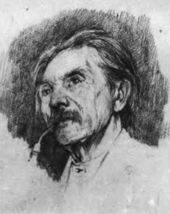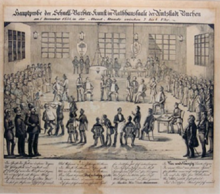Jakob Fehr

Jakob Fehr (born September 15, 1821 in Großeicholzheim ; † January 1, 1900 there ) was a German lithographer and photographer .
Life
Jakob Fehr came from a family that had already resided in Großeicholzheim in the 17th century, but originally came from Switzerland and perhaps came to the region during the course of the repopulation after the Thirty Years' War . Several men named Fehr had already been bailiffs of the Counts of Degenfeld-Schonburg, including a Jacob Fehr around 1749.
The later lithographer and photographer was born as the son of the farmer Johann Friedrich Fehr and his wife Elisabeth, née Heckler, at Butzengasse 2. He should probably have taken over his parents' farm, but instead set up the Jakob Fehr Lithographic and Photographic Institute in his hometown, which was still very rural at the time . Little is known about his early years. From the years 1839 to 1846 he made sketches based on nature that have been preserved in a sketchbook. They show buildings and landscape elements, but also figure studies that in part touch on the caricaturistic . Fehr not only depicts scenes from his immediate surroundings. The sketchbook also contains drawings of the Teusserschlösschen , the Löwenstein ruins and the Weibertreu castle . In Heilbronn , he apparently attended the flag consecration of the Urbanus choir, as he depicted the grandstand that was decorated for this event in 1842. In 1846 he seems to have traveled via Weinsberg to Esslingen am Neckar , where he drew the Frauenkirche .
Jakob Fehr was probably influenced by contemporary illustrated paperbacks such as the Spinnstube , of which numerous volumes have survived in his house. Ludwig Richter , among others, worked for the spinning room .
His travels may have brought Fehr into contact with printing companies and picture publishers such as the Wolff brothers in Heilbronn or Jakob Ferdinand Schreibers in Esslingen and may have induced him to forego the agricultural part of the Fehr property when dividing the estate and instead to live on art . Fehr was also deputy council clerk in his home town from 1870 to 1876. The death register from 1900 records him under the name "lithographer".
Works
Many of Fehr's lithographs have apparently not been preserved. Only two of his sheets of pictures seem to exist, including the sheet titled as the main sample of fast barber art , which he created on the occasion of a shave record attempt by barber Baumann from Buchen in 1858. This picture adorned the walls of numerous barber shops in the decades that followed. It was subtitled with a four-stanza poem, which was probably also by Fehr. One copy is in the Hygiene Museum in Dresden .
The second surviving picture sheet is more of a satirical type and bears the title The Mousche in the Fox Trap and shows a Jewish trader who is found lamenting by a hunter in a fox trap, which he did not fall into by accident. An explanatory poem has also been added to this picture. Fehr used the pseudonym "Waldheiner" for this representation .
In addition to these picture sheets, Jakob Fehr reproduced religious murals. We know, for example, of an Our Father text , which is surrounded by a picture story, in which the story of a Swiss alpine farmer is told, to whom many terrible things happen, but who is always lifted up by the Our Father and gains support. Fehr may have used an older model for his reproduction. Such murals can evidently be easily placed in the evangelical building sites that were once imperial knighthood .
Fehr also published views of the building land, although he did not always use his own drawings as templates. For a view of Adelsheim that Fehr reproduced, a drawing by his son Julius , who had received an academic education , could be used as a template . Jakob Fehr himself, however, is likely to have made the very detailed drawing of the tar furnace from Haseneck in Großeicholzheim, which existed until around 1850. It is one of the few images of wagon lubricators from the 19th century.
Another line of business seems to have been the production of letterheads etc. for industrialists and tradespeople, and Fehr also printed postcards, as demonstrated by a needle engraving on a printing stone that had been preserved until at least the 1970s. He showed a view of the place Großeicholzheim and the text "Greetings from Großeicholzheim".
Finally, the photographic studio that Fehr ran in his house on Butzengasse should not be neglected as a source of income.
Traces of his activity in Butzengasse were the paving stones in the small courtyard in front of the house, which consisted of used pressure stones. A room on the upper floor of the house, in which the stones were apparently prepared, still bears the name "grinding room"
It is not known exactly what prices Fehr asked for his lithographs and how high the editions were. In any case, Fehr also worked for printing works in the small towns around him; Among other things, he created a lithograph for E. Hubert & Co. in Adelsheim, which shows a townscape. He probably also used wandering traders to spread his pictures.
progeny
Jakob Fehr married Magdalena Hettinger from Bofsheim in the middle of the 19th century . The marriage resulted in two sons, one of whom died as a child. The son Julius, born on June 26, 1855, is one of the more important Baden painters of the 19th century. He completed an art degree in Karlsruhe , where, in addition to landscape painting, genre and portrait painting were also cultivated. Julius Fehr later distinguished himself in this area. Furthermore, a social interest can be read from his pictures; The picture The Winkeladvokat, for example, shows two farmers being ripped off by a lawyer. Like his father, Julius Fehr showed many views of the building land and the surrounding area. Julius Fehr probably took the trip to Italy, which was almost obligatory for young artists of his time, and then settled in Stuttgart for some time , where he probably made the acquaintance of his later partner Olga Lewering, whom he married in 1891. The couple had three daughters, the second of whom was born in Julius Fehr's hometown in 1893. Julius Fehr may have complied with Jakob Fehr's request to continue the lithographic and photographic establishment and therefore withdrew to Großeicholzheim. However, the company was not allowed to continue for long after the high-speed presses and rotary printing machines appeared in the 1860s . In addition to pictures for the local and neighboring churches, the painter Julius Fehr created numerous village milieu studies during his time in Großeicholzheim, evidently knowing that he was portraying a disappearing world. One of his works came under the title The First Timetable of the Royal Württemberg State Railways in the Nuremberg Transport Museum . It probably fell victim to the events of World War II . Since Julius Fehr apparently could not live on the income in his hometown, he moved to Mannheim in 1895 , where he opened a painting school. He also taught at the trade school in Mannheim.
Julius Fehr died of cardiac paralysis at the age of 45 in the same year as his father Jakob. His daughter Olga later worked as a painter in New Hampshire , his daughter Ida, who died in 1941, temporarily ran a photo studio in Esslingen and worked as an actress, and a son of their daughter Elisabeth became a caricaturist in Yugoslavia .
Works by Jakob and Julius Fehr, which were initially still in the family's house at Butzengasse 2 in Großeicholzheim, were apparently lost or destroyed in the war and post-war period. Jakob Fehr's great-grandson Edgar Lünig, a son of granddaughter Ida, collected the leftovers in 1952 and took them into safekeeping.
literature
- Peter Assion : Pictures for the farm and town house. The artistic work of Jakob and Julius Fehr, Großeicholzheim . In: Badische Heimat 55, 1975, pp. 153-176 ( digitized version ).
Web links
Individual evidence
| personal data | |
|---|---|
| SURNAME | Fehr, Jakob |
| BRIEF DESCRIPTION | German lithographer and photographer |
| DATE OF BIRTH | September 15, 1821 |
| PLACE OF BIRTH | Großeicholzheim |
| DATE OF DEATH | January 1, 1900 |
| Place of death | Großeicholzheim |

